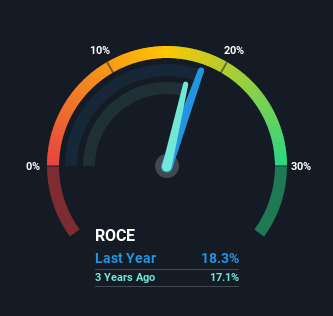SLC Agrícola (BVMF:SLCE3) Is Doing The Right Things To Multiply Its Share Price
If we want to find a stock that could multiply over the long term, what are the underlying trends we should look for? Ideally, a business will show two trends; firstly a growing return on capital employed (ROCE) and secondly, an increasing amount of capital employed. Ultimately, this demonstrates that it's a business that is reinvesting profits at increasing rates of return. So on that note, SLC Agrícola (BVMF:SLCE3) looks quite promising in regards to its trends of return on capital.
What is Return On Capital Employed (ROCE)?
For those who don't know, ROCE is a measure of a company's yearly pre-tax profit (its return), relative to the capital employed in the business. Analysts use this formula to calculate it for SLC Agrícola:
Return on Capital Employed = Earnings Before Interest and Tax (EBIT) ÷ (Total Assets - Current Liabilities)
0.18 = R$1.1b ÷ (R$9.1b - R$2.9b) (Based on the trailing twelve months to March 2021).
Thus, SLC Agrícola has an ROCE of 18%. That's a relatively normal return on capital, and it's around the 15% generated by the Food industry.
View our latest analysis for SLC Agrícola

In the above chart we have measured SLC Agrícola's prior ROCE against its prior performance, but the future is arguably more important. If you'd like to see what analysts are forecasting going forward, you should check out our free report for SLC Agrícola.
What Can We Tell From SLC Agrícola's ROCE Trend?
The trends we've noticed at SLC Agrícola are quite reassuring. The data shows that returns on capital have increased substantially over the last five years to 18%. Basically the business is earning more per dollar of capital invested and in addition to that, 74% more capital is being employed now too. So we're very much inspired by what we're seeing at SLC Agrícola thanks to its ability to profitably reinvest capital.
Our Take On SLC Agrícola's ROCE
To sum it up, SLC Agrícola has proven it can reinvest in the business and generate higher returns on that capital employed, which is terrific. Since the stock has returned a staggering 747% to shareholders over the last five years, it looks like investors are recognizing these changes. So given the stock has proven it has promising trends, it's worth researching the company further to see if these trends are likely to persist.
One more thing to note, we've identified 2 warning signs with SLC Agrícola and understanding these should be part of your investment process.
While SLC Agrícola isn't earning the highest return, check out this free list of companies that are earning high returns on equity with solid balance sheets.
When trading stocks or any other investment, use the platform considered by many to be the Professional's Gateway to the Worlds Market, Interactive Brokers. You get the lowest-cost* trading on stocks, options, futures, forex, bonds and funds worldwide from a single integrated account. Promoted
New: Manage All Your Stock Portfolios in One Place
We've created the ultimate portfolio companion for stock investors, and it's free.
• Connect an unlimited number of Portfolios and see your total in one currency
• Be alerted to new Warning Signs or Risks via email or mobile
• Track the Fair Value of your stocks
This article by Simply Wall St is general in nature. It does not constitute a recommendation to buy or sell any stock, and does not take account of your objectives, or your financial situation. We aim to bring you long-term focused analysis driven by fundamental data. Note that our analysis may not factor in the latest price-sensitive company announcements or qualitative material. Simply Wall St has no position in any stocks mentioned.
*Interactive Brokers Rated Lowest Cost Broker by StockBrokers.com Annual Online Review 2020
Have feedback on this article? Concerned about the content? Get in touch with us directly. Alternatively, email editorial-team (at) simplywallst.com.
About BOVESPA:SLCE3
SLC Agrícola
Produces and sells agricultural products in Brazil and internationally.
Good value average dividend payer.
Market Insights
Community Narratives




